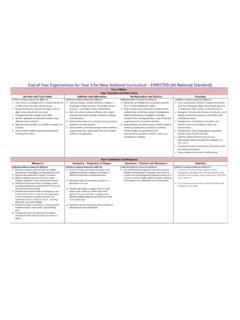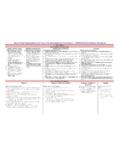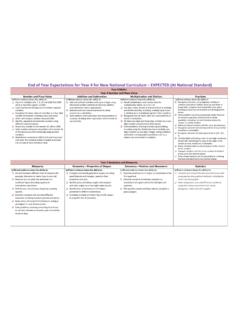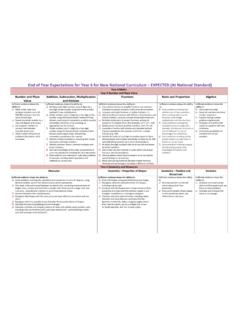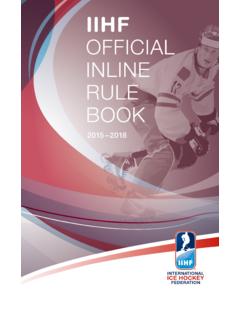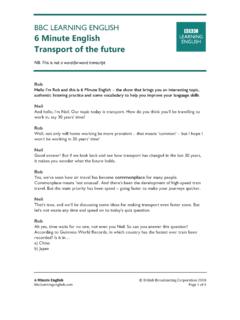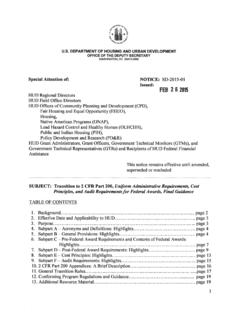Transcription of End of Year Expectations for Year 1 for New National ...
1 End of Year Expectations for Year 1 for New National curriculum expected (At National Standard) Year 1 Maths Year 1 Number and Place Value Number and Place Value Addition and Subtraction Multiplication and Division Fractions Sufficient evidence shows the ability to: Count to and across 100, forwards and backwards, beginning with 0 or 1, or from any given number. Count, read and write numbers to 100 in numerals; count in multiples of 2s, 5s and 10s. Given a number, identify 1 more and 1 less. Identify and represent numbers using objects and pictorial representations including the number line, and use the language of: equal to, more than, less than (fewer), most, least. Read and write numbers from 1 to 20 in numerals and words. Sufficient evidence shows the ability to: Read, write and interpret mathematical statements involving addition (+), subtraction ( ) and equals (=) signs.
2 Represent and use number bonds and related subtraction facts within 20. Add and subtract one-digit and two-digit numbers to 20, including 0. Solve one-step problems that involve addition and subtraction, using concrete objects and pictorial representations, and missing number problems such as 7 = ? 9. Sufficient evidence shows the ability to: Solve one-step problems involving multiplication and division, by calculating the answer using concrete objects, pictorial representations and arrays with the support of the teacher. Sufficient evidence shows the ability to: Recognise, find and name a half as 1 of 2 equal parts of an object, shape or quantity. Recognise, find and name a quarter as 1 of 4 equal parts of an object, shape or quantity. Year 1 Geometry and Measures Measures Geometry Properties of Shapes Geometry Position and Movement Sufficient evidence shows the ability to: Compare, describe and solve practical problems for: lengths and heights [for example, long/short, longer/shorter, tall/short, double/half] mass/weight [for example, heavy/light, heavier than, lighter than] capacity and volume [for example, full/empty, more than, less than, half, half full, quarter] time [for example, quicker, slower, earlier, later] Measure and begin to record the following.
3 Lengths and heights mass/weight capacity and volume time (hours, minutes, seconds) recognise and know the value of different denominations of coins and notes sequence events in chronological order using language [for example, before and after, next, first, today, yesterday, tomorrow, morning, afternoon and evening] . Recognise and use language relating to dates, including days of the week, weeks, months and years. Tell the time to the hour and half past the hour and draw the hands on a clock face to show these times. Sufficient evidence shows the ability to: Recognise and name common 2-D and 3-D shapes, including: 2-D shapes [for example, rectangles (including squares), circles and triangles] 3-D shapes [for example, cuboids (including cubes), pyramids and spheres].
4 Sufficient evidence shows the ability to: Describe position, direction and movement, including whole, half, quarter and three-quarter turns. Year 1 Reading Word Reading Comprehension Sufficient evidence shows the ability Apply phonic knowledge to decode words. Respond with the correct sound to graphemes for all 40+ phonemes, including alternative sounds. Read accurately by blending sounds in unfamiliar words containing GPCs taught. Read a range of simple common exception words the, said, they, once, she, friend, school. Read words with the endings -s, -es, -ing, -ed and -est. Read words of more than one syllable which contain GPCs known. Read contractions I'm, can t, we'll. Know that apostrophes represent omitted letters. Read some phonically-decodable books, closely matched to phonic knowledge.
5 Read pseudo (alien) words with accuracy, including vowel digraphs and trigraphs. Sufficient evidence shows the ability Listen to, discuss and enjoy a wide range of poems and stories at a level beyond that which they can read independently. Become familiar with key stories, fairy stories and traditional tales; retell them; know their characteristics. Link what they read to their own experiences. Recognise and join in with predictable phrases in poems and stories. Appreciate some rhymes and poems; recite some by heart. Discuss the meanings of new words, linking them to words already known. Listen to, discuss and enjoy a range of non-fiction texts; draw on what they already know, and on background information and vocabulary provided by the teacher. Check that texts make sense when reading; self-correct and re-read inaccurate reading.
6 Talk about the significance of the title and events. Infer on the basis of what is said and done know that Jack is scared of the giant because he is hiding; the princess is sad because she has lost her ring. Predict what might happen on the basis of what has been read so far the boy will be in trouble for stealing the buns. Participate in discussion about what is read to them, taking turns and listening to others. Explain clearly their understanding of what is read to them. Year 1 Writing Transcription Composition Spelling Sufficient evidence shows the ability Write from memory, simple dictated sentences containing the GPCs and words taught so far. Spell words containing each of the 40+ phonemes taught so far. Most words can be deciphered. Spell words using the prefix un- unhappy, unfair; the suffixes ing, -ed, -er and est where no change is made to the root word.
7 Spell most common exception words in the YR 1 spelling appendix. Recognise and spell a set of simple compound words. Understand the difference between singular and plural. Add suffixes s and es to words cats, witches, catches. Name the letters of the alphabet in order. Handwriting Evidence: Most letters are correctly formed and orientated, including lower case, capital letters and digits; there may be some inconsistency in size. Capital letters formed correctly for some names of people, places and the days of the week. Some spaces are left between words, although inconsistent. Most letters sit on the line correctly. Composition: structure and purpose Sufficient evidence shows the ability Compose sentences orally before writing; talk about where the sentence begins and ends.
8 Attempt to write appropriately to the task. Sequence simple sentences and sentence-like forms to form short narratives based on real or fictional experiences. Compose orally and write simple poems. Re-read writing to check it makes sense. Discuss own writing with others; make simple changes where suggested. Vocabulary, grammar and punctuation Sufficient evidence shows the ability Write sentences or sentence-like structures which can be clearly understood. Often use and to join words and clauses. Sometimes use a capital letter and full stop to show sentence boundaries; sometimes use question mark or exclamation mark in the right place. Sometimes use a capital letter for the names of people and places, days of the week, and for the personal pronoun I.
9 Sometimes include adjectives for description. Begin to use some features of Standard English I did.
